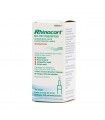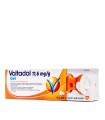ACTION AND MECHANISM
- [ANTIALOPECICO] with vasodilator action.
- The mechanism of action by which minoxidyle stimulates hair growth is not known exactly; there has been a possible alteration of androgenic metabolism in the scalp, or also a vasodilator effect that can increase microcirculation around the hair follicle.
Applied locally, minoxidyl stimulates the growth of in vitro and in vivokerocytes, does not increase the number of hair follicles but partially converts miniaturized and intermediate hairs into terminal hairs slowing the progression of androgenic alopecia in certain patients.
Such stimulation occurs after 4 or more months of treatment, and is of variable intensity between patients. After 6-12 months of uninterrupted treatment, 1/3 of the patients have had positive responses. However, discontinuation of treatment stops hair growth, and in 3-4 months pretreated alopecia can be returned.
SPECIAL WARNINGS
- Prior to its application it will be necessary to perform a medical history and a complete physical examination.
- Do not use in the presence of scalp wounds or dermatosis until they have healed, because there may be increased absorption and systemic adverse effects.
- There is a possibility of small local absorption through the scalp so regular monitoring of blood pressure and heart rate is recommended, per month of starting treatment and every 6 months later.
- Because of its content in ethanol and/or propylene glycol as excipients, frequent applications may cause skin irritation and dryness.
- It is advised to consult the dermatologist if there is no hair growth in women at 8 months using concentration at 2% and in men at 12 months using concentration at 2% or 4 months with concentration at 5%.
- Topical minoxidyl treatment is not indicated when there is no family history of hair loss, or if hair loss is sudden (alopecia areata) and/or irregular (e.g. scar tissue alopecia), if hair loss is associated with pregnancy, childbirth or serious illnesses (e.g. thyroid dysfunction, lupus, hair section loss associated with scalp inflammation or others), or if the reason for hair loss is unknown.
- Some patients have experienced changes in hair color and/or texture with the use of topical minoxidyle.
- An increase in hair loss may occur due to the action of minoxidyle, which initially produces a change from the telogen rest phase of the hair to the anagen growth phase (loss of old hair while the new ones grow in place). This temporary increase in fall usually occurs between 2 and 6 weeks after starting treatment and decreases in a couple of weeks (first sign of the minoxidil effect). If hair loss persists patients should stop treatment and consult their doctor.
Elderly
The safety and efficacy of topical minoxidil in patients over 65 years of age have not been established, so it is not known whether they respond differently to the drug, and their use in this age group is not recommended.
PATIENT ADVICE
- In the case of any heart problem, even in the past, it is necessary to consult with your doctor before using minoxidil for the first time. Also, tell your doctor and/or pharmacist if systemic effects such as accelerated heartbeat or palpitations occur; rapid and unexplained weight gain; swelling of the hands, elbows and face; lightheadedness, dizziness or fainting; blurred vision; chest, hand or shoulder pain or scalp irritation or any other reaction you suspect may be due to the application of this medicine. In such cases, stop treatment.
- This product is for application on the scalp, so it should be avoided for ingestion or inhalation.
- For the correct application read the instructions in the package leaflet carefully.
- Apply to the perfectly dry scalp starting at the center of the area to be treated, and by a massage with the fingertips, spread the product in the area to be treated.
- Hand washing with plenty of water before and after application is recommended. Special care should be taken to wash your hands after application, especially in the case of women, as there is a risk of hair growth elsewhere in the body.
- Do not use a dryer to speed up hair drying because hot air can evaporate the product and decrease effectiveness.
- The recommended daily dose should be respected regardless of the extent of alopecia. Higher use than recommended dosage or application most often does not improve the outcome.
- The patient should be warned that prior treatment of 4 months may be necessary before there are signs of hair growth.
- When treatment is discontinued, growth may cease and return to the initial state of alopecia in 3-4 months.
Contraindications
- Hypersensitivity to any of the components of the preparation.
DRIVING EFFECTS
According to the pharmacodynamic and general safety profile of minoxidil when administered topically, it is unlikely to affect the ability to drive or use machines.
Pregnancy
Animal safety: Animal studies have not shown a harmful effect on pregnancy, embryonic/foetal development, childbirth or during postnatal development. Only a risk to the fetus with very high exposure levels (compared to those intended for human exposure) has been demonstrated.
Safety in humans: There are no adequate and well-controlled studies in pregnant women.
Because of the unavailability of clinical data on the exposure of pregnant women to topical minoxidil, it can be considered that, although remotely, a risk of foetal harm in humans is possible. Thus, minoxidil is not recommended during pregnancy, and should be used only if the benefit to the mother outweighs the potential risk to the fetus.
Effects on fertility :no specific human studies have been conducted.
Pharmacokinetics
Topical route.
- Absorption: slight absorption (bioavailability 1.4-1.7%). After application of 1 ml, the amount of minoxidil absorbed is approximately 0.28 mg (20 mg/ml) and 0.85 mg (50 mg/ml).
Above doses ranging from 2.4 to 5.4 mg/day some systemic effect could be foreseen. This dose could be reached if minoxidil 5% were applied to the entire surface of the scalp without limiting it to allopetic plaque. The smallest dose of minoxidil I.V. that produces clinically significant hemodynamic effects in patients with mild to moderate hypertension has been observed to be 6.86 mg.
The results of pharmacokinetic studies indicate that the three most important factors in relation to increased absorption of minoxidil into the skin are:
- quantitative increase in the applied dose.
- increased frequency of application.
- reduction of the barrier function of the stratum corneum of the epidermis.
Serum concentrations of minoxidil after topical application depend on the rate of percutaneous absorption. The influence of concomitant dermatological disorders on the absorption of minoxidil has not been determined.
After application of minoxidil by skin, the absorption of the same is not influenced by factors such as: sex, exposure to ultraviolet rays, simultaneous application of a moisturizing product, occlusion (use of false hair), evaporation of the solvent (use of a dryer) or the surface of the application area.
- Metabolism: The biotransformation of the absorbed minoxidil after topical application is not well known. It is believed that approximately 60% of the minoxidil absorbed is metabolized to minoxidil glucuronid, mainly in the liver.
- Elimination: Minoxidil and its metabolites are dialysable; its elimination is basically urinary. When topical application is discontinued, approximately 95% of the absorbed minoxidil is removed within 4 days.
Indications
- [ALOPECIA ANDROGENICA].
* Treatment of moderate intensity androgenetic alopecia (hair loss) in men.
Interactions
- Tretinoin: increases percutaneous absorption of minoxidil as a result of increased permeability of the stratum corneum.
- Betamethasone dipropionate: increases minoxidil concentrations in local tissues and decreases systemic absorption of minoxidil.
- Antihypertensives: Although not clinically proven, there is a possibility that minoxidil will increase the risk of orthostatic hypotension in patients receiving concomitant treatment with peripheral vasodilators and antihypertensive drugs such as guanetidine and derivatives.
In general, minoxidil should not be applied concomitantly in the same area with other topical products such as corticosteroids, retinoids or occlusive ointments, because of the increased risk of absorption.
Breast feeding
Absorbed minoxidil is systematically excreted in human milk.
Therefore, topical minoxidil should only be used during lactation if the benefit to the mother outweighs the potential risk to the infant.
Children
The safety and efficacy of skin-administered minoxidyle in children and adolescents < 18 years have not been evaluated, so it is recommended to avoid use in this age group.
RULES FOR PROPER ADMINISTRATION
Using the dosing pump
- Before applying the product, you should make sure that the hair and scalp are completely dry. Wash hands well before and after applying the solution.
- Remove the bottle cap and unscrew the closing cap.
- Adapt by screwing the dosing pump into the bottle.
- For application: direct the pump towards the center of the area to be treated. Press once and extend the product with your fingertips in order to cover the entire area to be treated, starting from the center of it. Repeat the operation 6 times in order to apply a total dose of 1 ml.
- Do not apply the product to other parts of the body, and avoid inhalation of the product during application.
-Some presentations with dosing pump also have a cannula and nozzle for more localized administration, in less extensive areas of the scalp.
Treatment of wide surfaces of the scalp: the applicator will be used with spray pump and dispenser.
a) Remove the outer most transparent cap.
b) Remove and discard the inner cap.
c) Place the sprayer inside the bottle and screw it firmly. Remove the small transparent cap.
d) Direct the sprayer outlet hole towards the center of the area to be treated. Press once and extend the solution throughout the area with your fingertips. Perform 5 more keystrokes (total 6) repeating the same operation each time. After 6 pulsations the dose of 1 ml will have been applied.
e) After using the bottle, re-cover it with the external transparent cap.
Treatment of small surfaces or under the hair: the applicator will be used with cannula and nozzle.
a) Remove the outer most transparent cap.
b) Remove and discard the inner cap.
c) Place the sprayer inside the bottle and screw it firmly. Remove the small transparent cap.
d) Pull up to remove the sprayer head.
e) Insert the cannula nozzle into the headless end of the sprayer and press firmly.
f) Direct the cannula towards the center of the surface to be treated or under the hair, press once and extend the solution with the tip of the fingers. Perform 5 more keystrokes (total 6), repeating the same operation each time. After 6 pulsations the dose of 1 ml will have been applied.
Dosage
Skin topic.
- Adults: 1 ml/12 hours (corresponding to 10 sprays 2 times a day), applied to the scalp starting at the center of the area to be treated. The recommended daily dose should be observed regardless of the extent of alopecia.
1 ml equals 10 sprays of the dosing pump.
Maximum daily dose: 2 ml.
Precautions
- Scalp dermatosis: In patients with dermatosis or scalp skin lesions, greater percutaneous absorption of the active substance may occur, so make sure that these do not exist before application.
- Although studies with topical minoxidil have not shown significant systemic absorption, there is a possibility of small local absorption through the scalp, so regular monitoring of blood pressure and heart rate is recommended in patients with a heart or cardiovascular problem such as: potential risk of [ARTERIAL HYPERTENSION] , [EDEMA], [PERIPHERICAL ARTERIOPATIA], [CARDIAC ARRHYTHMIA], [CARDIAC INSUFFICIENCY] or [VALVULOPATIA].
- It is not recommended to use wigs during treatment.
ADVERSE REACTIONS
Adverse reactions are described according to each frequency interval, considered very common (>10%), common (1-10%), uncommon (0.1-1%), rare (0.01-0.1%), very rare (<0.01%) or of unknown frequency (cannot be estimated from the available data).
The most common adverse reactions are mild dermatological alterations in the application area, such as: flaking, erythema, dermatitis, hypertricosis (in distal areas), stinging, itching and dry skin (mainly due to ethanol content).
But the rest of the following adverse reactions may be observed:
- Cardiovascular: uncommon [TAQUICARDIA], [PALPIITATIONS], [HIPOTENSION], increase or decrease of pulse.
- Neurological/psychological: uncommon [CEFALEA], [PARESTESIA]; [MAREO], [DISGEUSIA]; unknown frequency [DEPRESION].
- Respiratory: frequent [DISNEA]; [SINUSITIS], [RINITIS].
- Dematological/hypersensitivity: common [PRURITO], [SKIN IRRITATION], [CONTACT DERMATITIS], [SKIN DRYNESS], [EXFOLIATIVE DERMATITIS]; uncommon [ALOPECIA] (especially at the start of treatment), in uniform hair, [HIRSUTISM]; very rare [ACNE]; unknown frequency [ANGIOEDEMA].
- Genitourinarias: [GENION ERECTIL].
- Allergic: very rare [HYPERSENSITIVITY REACTIONS], with [RINITIS], [EXANTEMATIC ERUPTIONS], generalized [ERYTHEMA] or facial oedema.
- Osteomusculars: unknown frequency [OSTEOMUSCULAR PAIN].
- Ophthalmological: uncommon [LAGRIMEO], altered vision, vision disturbances.
- Erotics: uncommon [OTITIS], especially [EXTERNAL OTITIS].
ADVERSE REACTIONS RELATING TO EXCIPIENTS
- This medicine contains propylene glycol, so it may produce [SKIN IRRITATION].
Overdose
There is no evidence that, when applied skinly, minoxidil is absorbed in sufficient amount to cause systemic effects. Therefore, when used as directed, an overdose is unlikely. But if this product is applied in an area where the integrity of the epidermal barrier is compromised (due to trauma, inflammation or skin disease), there is a possibility of a systemic effect of overdose.
- Symptoms: Accidental or voluntary overdose after topical application will result in an increase in the intensity of dermatological adverse reactions, especially itching, dryness, skin irritation and eczema. In addition, systemic absorption will be greater, with the consequent increase in the likelihood of systemic effects, especially cardiac, due to the vasodilator action of minoxidil (5 ml of 2% solution contain 100 mg minoxidil, which is the maximum dose used orally, in adults, for the treatment of high blood pressure).
Signs and symptoms of overdose, resulting from rapid and almost complete absorption of the active substance at the gastrointestinal tract level, include: hypotension, tachycardia, hydrosaline retention with the appearance of edema, pleural effusion or congestive heart failure.
- Treatment: Treatment of the overdose table developed by accidental ingestion should be symptomatic and supportive, and may require the use of diuretics for edema, beta-blockers or other sympathetic nervous system inhibitors for tachycardia and sodium chloride in intravenous isotonic solution for hypotension. Sympathomimetics, such as adrenaline and norepinephrine, should be avoided by the over-heart stimulation they produce.































